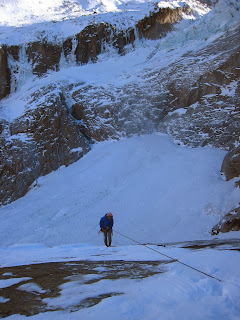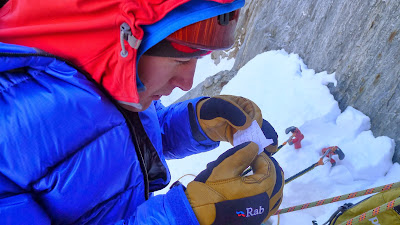This Autumn hasn't been the most productive, due to really
poor weather and conditions. Mostly I've
just been training either at the zoo, which is the local dry tooling venue, or
at the wall. So I'm feeling strongish on the axes just now. However I've not
done that much in the mountains so I wasn't sure what my head would be like on a
hard mixed traditionally protected route.
 |
| Climber on the 'Deferlante', a WI4 next to Sector Ecosse. |
So on Saturday Graham Mcgarth and Myself went up to the Rive
Gauche area, to go have a look at 'Bringing home the bacon'. It was a route put
up a few years ago by Nick Bullock and Pete Benson. They plus a few other Brits managed to develop
a lot of cool routes on this wall. The sector got nicknamed 'Sector Ecosse' as
it's all traditionally protected, and you can find yourself climbing on a lot
of turf. So was quite nice to go and feel like I was home again, even just for
a little while. Well... Not that little, I did take my time on the route.
Purely just to feel like I was in my homeland, not because I was pumped out of
my little mind.
'Bringing home the Bacon' is about Scottish VIII, 8 or M6+.
It has 3 pitches but I wouldn't recommend the first if it isn't that snowy, as
we found out. The crag is easily accessed in 20 mins from the Grandes Montes
mid station. We skinned in from the mid station so we could ski back down the
home run, but you can easily walk in from the lift station as well.
 |
| Me rapping in from the top. |
 |
| Graham rapping into the first pitch. |
Once we found the top of the route, we tied a 50m sport rope
to a boulder. Then we abbed down that and rapped off or half ropes from the end
of the sport rope. This easily brings you to the top of the first pitch. We
decided to do the first pitch for the sake of it, so we did one more short rap
down. Like I said I wouldn't recommend this pitch if there's not a lot of snow
and ice around, it's just easy grooves with a lot of loose rocks lying around.
 |
| Next time gonna make the description a bit bigger, or bring my glasses. |
Graham lead the second pitch, which climbs this awesome
crack line that goes straight up this wall. It has a few cracked bulges at the
top of the pitch which gets the forearms going. Unfortunately there wasn't much
ice in the crack. Which does make it easy for finding the gear, but I think it'd
feel even more enjoyable to climb with ice filled cracks.
 |
| Graham starting the second pitch. |
 |
| Me on the last bulges of the second pitch. |
The last pitch is the crux, and I was quite keen to give it
a bash and see what my head would be like on a hard lead. From the belay you
climb diagonally up left on these obvious cracks filled with turf. You get
really good pro and the after about 20m you'll find some in-situ wires, below
this bulging roof. From here you traverse hard left for about 15m. The start of
the traverse isn't too bad, you get some really good horizontal torques along
with good protection. The feet are pretty small and spaced apart, so good feet
work along with sharp points on the crampons is well recommended. Especially
just before the end of the traverse, where it's pretty thin and bold. Take a
few knifeblades, I did but Graham decided to keep them on his harness. At the end of the traverse you come to a blank
slab, which I convinced myself was the way. I didn't fancy climbing the bulge
above me as I was sure that it looked really steep and pumpy. So I was sure I
had to carry on the traverse for another few metres, until Graham told me to
man up and go straight up. Turns out it wasn't nearly as bad as it looked. Good
blob of turf, then some cracked blocks brings you to the top. I was told to
take a stubby ice screw as normally the exit is a streak of ice, I didn't need
it this time, but would recommend taking one just in case. It was a really cool route and I would go back and do it again another time when there's a bit more ice. Great fun to get pumped and scared again. Luckily for me it was still daylight when I was climbing,
but unfortunately the light was disappearing
whilst Graham was on the traverse so had to just trust anything that his feet
would land on.
 |
| Me starting up the third pitch, Unfortunately the camera stopped working after this photo. |
We packed the bags, slung them on our backs and clipped into
our adorable little approach skis. This was the first time skiing and mixed
climbing in my new Zamberlan boots. Skiing in climbing boots requires a lot
more balance than normal skis boots as you don't have these big plastic cuffs
to support your ankle. However some boots like the Spantik ski pretty well as
they have a stiff outer boot. So basically I'm just telling you my excuse for
falling over. Which is what happened at the bottom of the GM home run. I lost
my balance after hitting a patch of ice and then fell backwards. Then one ski released
and nose of it dived into the snow underneath me. However as I was still travelling
down the slope I landed on the tail end of my cut down skis, and ended up being
mounted on my ski like a shish Kebab. Which
resulted in torn soft shells, thermals, boxers and bawbag!
 |
| This was Pre 'Sac attack'! |




Great post Ally, what bindings do you use with your climbing boots to ski in? Cheers Joe
ReplyDeleteI've got a pair of Silveretta pure carbon. These are quite good. The Emery Crono's are really good as well and a lot lighter.
ReplyDeletecool thanks!
ReplyDelete